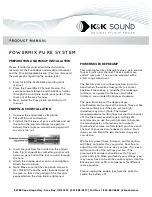
22
OPERATION PROCEDURE
TOS8870A
Logical elements, transistors or photocouplers may be used instead of the switches in Fig.3-4.
The example is shown in Fig.3-6. The input conditions of the Tester for such operation are as fol-
lows:
High level input voltage
: 11 V to 15 V
Low level input voltage
: 0 V to 4 V
Low level sweep out current
:
≤
5 mA
Input pulse width
: 20 ms minimum
Fig.3-6
The gates are pulled up to +15 V. Opening of the input terminals is equivalent to a high level
input.
•
Currents i and i' must be suf
fi
cient to provide currents Ic and Ic' of 5 mA or more.
•
When using the CURRENT MONITOR terminals, isolate the common line (line COM in
Fig.3-6) of the control circuit from the power line and ground line of the Tester.
•
A timing of STOP signal for clearing of FAIL alarm sends STOP signal more than 20 ms
after doing 100 ms or more after FAIL signal generated as follows.
Fig.3-7
With a view to prevent erroneous operation which could be caused by noise, it is recommendable to
use photocouplers as shown in Figure 3-6 or relays as shown in Fig.3-4.
The Tester is designed with full attention so that it does not erroneously operate by noise. Pay
attention so that the devices connected to the Tester do not erroneously operate by noise.
Note that the layout of pins of the REMOTE control connector is as per the DIN standard and is not
in the due order of number progression, as shown in Fig.3-8.
Fig.3-8
Layout of connector pins as viewed from panel surface
TOS8870A
5
4
3
2
1
REMOTE control connector
COM
START
20 ms or more
i
STOP
20 ms or more
i'
Ic'
Photocupler ON
Ic
DESCRIPTION
FAIL
STOP
100 ms or more
20 ms or more
1
2
3
4
5
















































